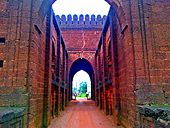Bishnupur
| Bishnupur | ||
|---|---|---|
|
|
||
| State : |
|
|
| State : | West Bengal | |
| District : | Bankura | |
| Sub-district : | Bishnupur | |
| Location : | 23 ° 5 ' N , 87 ° 19' E | |
| Height : | 75 m | |
| Area : | 22.02 km² | |
| Residents : | 12,660 (2011) | |
| Population density : | 575 inhabitants / km² | |
| Bishnupur - temple | ||
Bishnupur is a town of about 13,000 and capital of a community ( municipality ) with about 70,000 inhabitants (2011 census) in the eastern Indian state of West Bengal . The city is significant for several Bengali temples from the 17th century and for the Baluchari saris made here . The name of the city refers to the Hindu god Vishnu .
location
Bishnupur is between 70 and 80 m above sea level. d. M. and approx. 135 km (driving distance) northwest of Calcutta ; From there buses run almost every hour (travel time approx. 4.5 hours). The city also has a train station with train connections to all major cities in the region. The temple cities of Antpur and Kalna are about 95 km southeast and 140 km east, respectively.
population
Most of the city's residents are Hindus ; Muslims , Sikhs , Jains and Buddhists make up only a numerically small percentage of the population. They speak Bengali and Hindi . In contrast to the usual censuses in northern India, the male population only exceeds the female population by around 3%.
economy
Agriculture still plays the most important role in the villages around the city, which functions as a regional center of trade, crafts and services. The traditional production of terracotta figurines and silk saris brings income to the city's coffers, as does the predominantly Indian tourists.
history
Bishnupur was already an important place during the Gupta era . There are no records for the time thereafter; it is assumed that phases of dependency and those of extensive independence followed each other. In the 12th century the rise of Islam began, which reached its peak under the Mughal rulers; During this time - apart from the phase of the sultanate - Bengal was administered by governors ( subahdars ). The 16th to 18th centuries are the heyday of the place, because the Malla dynasty , who lived in the region as early as the 8th century and turned to Vishnuism , made Bishnupur their capital and built several important temple buildings in the Bengali style and a fort, which Architecturally, however, it is strongly oriented towards the defensive architecture of the Mughals .
Attractions
The most important sights are the many brick- built temples from the 17th and early 18th centuries, the heyday of the regional Malla rulers. They all belong to the Bengali temples , a special form of Hindu architecture, which is characterized by a curved roof shape with drooping corners ( Bengali roof ) as well as by tower-like attachments ( ratnas ) that have little in common with the shikharas or deuls of the north Indian Nagara style have to do. Some temples have gateways ; many facades are clad with terracotta reliefs. A special feature is the Rasmancha Temple , which takes up more than four times the floor space of most other temple buildings and is covered by a pyramid-shaped roof, which is accompanied by smaller roofs in the Bengali style above the arcaded gallery ( pradakshinapatha ).
photos
- temple
- Terracotta reliefs
Web links
- Temple in Bishnupur (Wikipedia English)
- Temple in Bishnupur



















